|
|
 |
|
Calanoida ( Order ) |
|
|
|
Diaptomoidea ( Superfamily ) |
|
|
|
Acartiidae ( Family ) |
|
|
|
Acartia ( Genus ) |
|
|
|
Acanthacartia ( Sub-Genus ) |
|
|
| |
Acartia (Acanthacartia) plumosa T. Scott, 1894 (F,M) | |
| | | | | | | Syn.: | no Acartia plumosa : Brodsky, 1948; 1950 (1967) (p.424, figs.F,M); Sewell, 1932 (p.395); 1934 (p.80); Wellershaus, 1969 (part., p.271, figs.M, no F, Table 3); Abraham, 1970 a (p.115, figs.F,M); Tranter & Abraham, 1971 (p.224, figs. 2Af, 2Bf) | | | | Ref.: | | | T. Scott, 1894 b (p.66, figs.F,M); Giesbrecht & Schmeil, 1898 (p.153); Steuer, 1923 (p.24, figs.F,M); Sewell, 1932 (p.395); Marques, 1953 (p.122, figs.F); Vervoort, 1965 (p.197, Rem.); Abraham, 1970 (p.52, Rem.); Greenwood, 1972 (p.317, Rem.); Goswami & Goswami, 1973 (p.242, fig.1, karyotypes); Ueda & Hiromi, 1987 (p.226, 230, 235, Redescr., figs.F,M, Rem.); Bradford-Grieve & al., 1999 (p.886, 962, figs.F,M). | 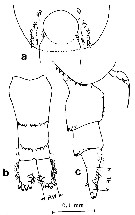 issued from : H. Ueda & J. Hiromi in Crustaceana, 1987, 53 (3). [p.227, Fig.2, a-c]. Female (from Pointe Noire, SE Atlantic): a, posterior metasome, b-c, urosome (dorsal and lateral, rspectively). Nota: Posterior corner of metasome rounded, on each side with 2 rows of conical spines and 1 fine hair laterally; medially with numerous minute spinules; Spines of outer row at 5 loci, each locus with 0-4 (usually 1 or 2) spines; spines of inner row smaller than those of outer and arranged in 2 groups, 7-13 smaller dorsal spines and 2-7 larger ventral spines. Genital segment with 7-10 spines on posterodorsal margin and 3 rows of very minute hair-like spinules on ventral surface, lateral surface without spinules. 2nd urosomal segment with 6-13 posterodorsal spines. Anal segment with ventrolateral hairs. Caudal rami as long as urosomal segment 2, asymmetrical with dorsal seta of right ramus more distally located than that of left; RL/RW 1.5-1.7; lateral and distomedial margins fringed by hairs.
|
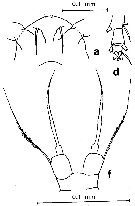 issued from : H. Ueda & J. Hiromi in Crustaceana, 1987, 53 (3). [p.228, Fig.3, d, f]. Female: a, forehead (ventral); d, right A1 (15th-17th segments); f, P5 (anterior view). Nota: A1 17-segmented, extending beyond last metasomal segment; 16th segment with a row of spinules on ventral surface. P: distal two-thirds of spine with dentate inner and outer margins.
|
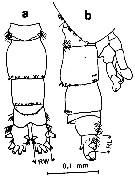 issued from : H. Ueda & J. Hiromi in Crustaceana, 1987, 53 (3). [p.229, Fig.4, a-b]. Male: a, urosome (dorsal); b, posterior metasome with P5 and urosome (lateral). Nota: Caudal rami RL/RW 0.9-1.0. Right A1 18 segmented, with geniculation between 14th and 15th segments; left A1 21-segmented.
|
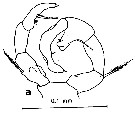 issued from : H. Ueda & J. Hiromi in Crustaceana, 1987, 53 (3). [p.231, Fig.5, a]. male: a, P5 (anterior view).
|
 issued from : H. Ueda & J. Hiromi in Crustaceana, 1987, 53 (3). [p.235, Table I]. Comparative list of characters in the Acartia plumosa - sinjiensis - tropica species group.
|
 issued from : A. Steuer in Arb. zool. Inst. Innsbruck, 1923, 1 (5). [p.24, Figs.110-114]. Female: 110, habitus (dorsal); 111, last thporacic segment and urosome (dorsolateral); 113, P5. Male: 112, urosome (dorsal); 114, P5, after T. Scott, 1894.
|
 issued from : A. Steuer in Arb. zool. Inst. Innsbruck, 1923, 1 (5). [Taf. II, Figs.13, 14]. Female: 13, genital segment (lateral; 14, idem (ventral).
|
 Issued from : S. Wellershaus in Veröf. Inst. Meeresf. Bremerhaven, 1969, XI. [p. 271, Figs. 71, 72]. Female (from Cochin Backwater, area between outlet and Aroor Bridge): 71, last thoracic segtment wit P5 and urosome (abdomen dorsolateral, caudal rami dorsal); 72, P5 (A: terminal spine lateral, B: posterior, C: detail). Scale bars: single = 100 µm; doble = 50 µm. Nota; - Ratio prosome : urosome = 3.45. - No spines on A1 except the spine on egment 7-8. - Anal operculum without spines. - Caudal rami: length : breadth = 12.5 : 5.0.
|
 Issued from : S. Wellershaus in Veröf. Inst. Meeresf. Bremerhaven, 1969, XI. [p. 272, Table 3]. Comparative list of characters in the Acartia plumos-chilkensis-Group.
| | | | | Compl. Ref.: | | | Sewell, 1948 (p.324, 431); Neto & Paiva, 1966 (p.28, Table III); Binet & al., 1972 (p.71); Dessier, 1979 (p.133, 201, 207); Ueda & al., 1983 (p.165, Table 1, 2, 3, 4, swarms); Brenning, 1985 a (p.16, 28, Table 2); Madhupratap & Haridas, 1986 (p.105, tab.2); Brenning, 1987 (p.34, Rem.); Diouf & Diallo, 1987 (p.260); Marcus, 1996 (p.143, as pulmosa); Mauchline, 1998 (tab.8); Madhu & al., 2007 (p.54, Table 4, abundance vs monsoon); Labat & al., 2009 (p.1747, Table 2); Trottet & al., 2017 (p. 7, Table 3: resting stage, as A. pulmosa) | | | | NZ: | 4 + 1 doubtful | | |
|
Distribution map of Acartia (Acanthacartia) plumosa by geographical zones
|
| | | | | |  Chart of 1996 Chart of 1996 | |
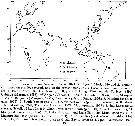 issued from : H. Ueda & J. Hiromi in Crustaceana, 1987, 53 (3). [p.232, Fig.6]. issued from : H. Ueda & J. Hiromi in Crustaceana, 1987, 53 (3). [p.232, Fig.6].
Distribution of the three species A. plumos, A. sinjiensis, A. topica. |
| | | | Loc: | | | Angola, Baia Farta, Congo, G. of Guinea, Ivorian shelf, Casamance, Mauritania, Azores-Portugal (in Labat & al., 2009), Indian (Sud Yemen, Mandovi-Zuari estuary, Cochin, Kerala, Salt Lakes), Singapore (in Trottet & al., 2017), ? Japan (Inland Sea).
Species type: from Congo mouth. | | | | N: | 17 | | | | Lg.: | | | (16) F: 1,15-1,08; (75) F: 1,21-1,14; M: 1,13-1; (93) F: 1,16-1,09; M: 1,05-1,01; (164) F: 1,18-1,17; (232) F: 1,1-0,9; M: 1-0,85; (1110) F: 1,2-1,3; {F: 0,90-1,30; M: 1,0-1,13} | | | | Rem.: | Form ± brackish, in estuaries; epipelagic.
The species resembles A. sinjiansis and A. tropica.
The geographical distribution remains unclear because of confusion with Acartia tropica and Acartia sinjiansis. For Wellershaus (1969, p.273), both A. chilkaensis and A. plumosa are related but well distinct species. The hitherto known forms can be arranged in the following order: A. plumosa (West Africa) - A. plumosa (Cochin) - A. chilkaensis sittangi (Burma) - A. chilkaensis (Chilka Lake).
Ueda & Hiromi (1987, p.230) points to the occurrence of the species from South Yemen. Atlantic and NW Indian populations are isolated from each other not only by the geographical distance but by the temperature barrier around South Africa (not encountered in this region); natural dispersion from the Atlantic to the Indian Ocean or vice versa seems unlikely. These two populations may not have been isolated for a long geological time, because specimens exhibited no morphological differences, even in details of ornamentation between the two populations. Synanthropic introduction by ship ballast water is one explanation given for geographical disjunct populations of brackish plankton copepods.
See table 1 from Greenwood ( 1972, p.317) to bayly (= Acartia sinjiansis).
After Ueda & al., 1983 (p.167: Table 2 & p.169: Table 4) at Maizuru Bay (Japan): (1)-Shape and diameter of swarm, (2)-depth (m), (3)- swarming position, (4)-number of samples examined, (5)-Mean % of adults (range), (6)- Mean % of females among adults (range).
(1)- irregular balls (5 cm-1 m); (2)- 0.3-10 m; (3)- over sandy or gravelly bottom; (4)- 12; (5)- 95.1 (83.8-99.9); (6)- 93.6 (80.0-99.7). | | | Last update : 25/02/2020 | |
|
|
 Any use of this site for a publication will be mentioned with the following reference : Any use of this site for a publication will be mentioned with the following reference :
Razouls C., Desreumaux N., Kouwenberg J. and de Bovée F., 2005-2025. - Biodiversity of Marine Planktonic Copepods (morphology, geographical distribution and biological data). Sorbonne University, CNRS. Available at http://copepodes.obs-banyuls.fr/en [Accessed September 15, 2025] © copyright 2005-2025 Sorbonne University, CNRS
|
|
 |
 |













